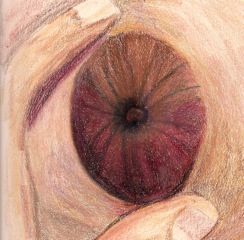About Flat and Inverted Nipples
It is common for women who are pregnant for the first time to have nipples that do not fully protrude; about one third of mothers have nipples with some sort of inversion. Because your baby takes in not just the nipple but also a significant portion of the surrounding breast tissue, flat and inverted nipples do not necessarily equate to breastfeeding latch-on difficulties for baby.
Flat or inverted nipples are caused when underlying adhesions in the nipple pull the nipple inward. They are usually identified when the nipple does not protrude or become erect when stimulated or cold. A “pinch test” that simulates the compression that occurs when baby is nursing may be part of your prenatal care by your midwife or obstetrician or during a prenatal breastfeeding consultation with your lactation consultant. An inverted nipple will retract, rather than protrude, when the areola is pinched; flat nipples will remain flat. A pinch test performed early in pregnancy may not be an accurate indicator that when baby arrives mom’s nipples will still be flat or inverted, because as pregnancy progresses, hormonal changes increase the size and protractibility of the nipples.
Prenatal Preparation
Awareness is the best prenatal preparation for breastfeeding. Various prenatal preparations used to be recommended to “treat” flat or inverted nipples, but research indicates that these interventions actually resulted in lower breastfeeding success, as minimal effectiveness was reported. A mother’s body is perfectly suited to feeding her baby and flat or inverted nipples are just a normal variation of breast anatomy; most types of flat or inverted nipples will cause no problems with breastfeeding.
Knowing that you have this normal variation empowers you to be proactive in seeking breastfeeding help, should it be needed, but does not necessarily equate to breastfeeding trouble. There is nothing special you need to do prenatally to prepare for breastfeeding, other than building your breastfeeding support team in case help is needed, just like all other moms.
Helping Baby Nurse
Babies are breastfed, not nipple fed. This is an important distinction for all mothers, but especially for those with flat or inverted nipples. If baby has a good latch he will take in a good mouthful of the breast, latching on to the areola, instead of the nipple, for effective breastfeeding.
Here are some techniques to help baby latch-on and nurse effectively with flat or inverted nipples:
Biological Nurturing
Biological nurturing or laid back positioning is a natural way to encourage your own and your baby’s instincts to facilitate effective latch and bonding. It can be used as soon as soon as possible after birth and for as long as baby maintains his innate reflexes to help him find the breast (several weeks or even a few months). Simply place baby on the mother’s chest or abdomen and allow him to crawl to the breast and latch-on on his own, providing a “safe space” with mother’s arms for him to do so. (See “Breastfeeding with Laid Back Positioning or Biological Nurturing” for more information.)
Breastpumps
Using a breastpump immediately prior to nursing can help draw the nipple out to make latch-on easier for baby. Using a breastpump for any reason other than milk removal should be done with caution, especially in the early days of nursing when there is concern for increasing the risk of engorgement. Use the pump in this fashion for only a minute or so, or just enough time to encourage the nipple to protrude. Keep baby close-by, so that he may be immediately brought to the breast before the nipple relaxes.
Breast Shells
Breast shells are hard plastic shells designed to help draw the nipple out. They can be worn in mother’s bra for about half an hour before nursing and should encourage the nipple to protrude.
Entice Baby to Latch with Expressed Milk
Mother can hand express a small amount of colostrum or milk, so that it lingers on her nipple when she brings baby in to latch. This entices him to latch-on to the breast and begin to suckle. (See “Hand Expression for Breastmilk” for more information.)
Manual Nipple Stimulation and Cold Therapy
A cold, wet cloth or an ice cube wrapped in a cloth can be used as cold therapy to encourage the nipple to become erect. Prolonged use of ice can cause the nipple and areola to become numb, so use this technique just long enough for the nipple to protrude. The same effect can be accomplished by using your fingers to roll your nipples between thumb and forefinger for a minute or two before nursing. The two means of stimulation (finger and cold therapy) can be used together.
Nipple Shields
Nipple shields may commonly be recommended for mothers with flat or inverted nipples, however nipple shields should not be dispensed lightly and should be received with informed consent. Please contact your lactation consultant before using a nipple shield.
